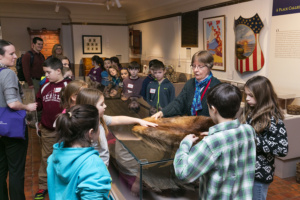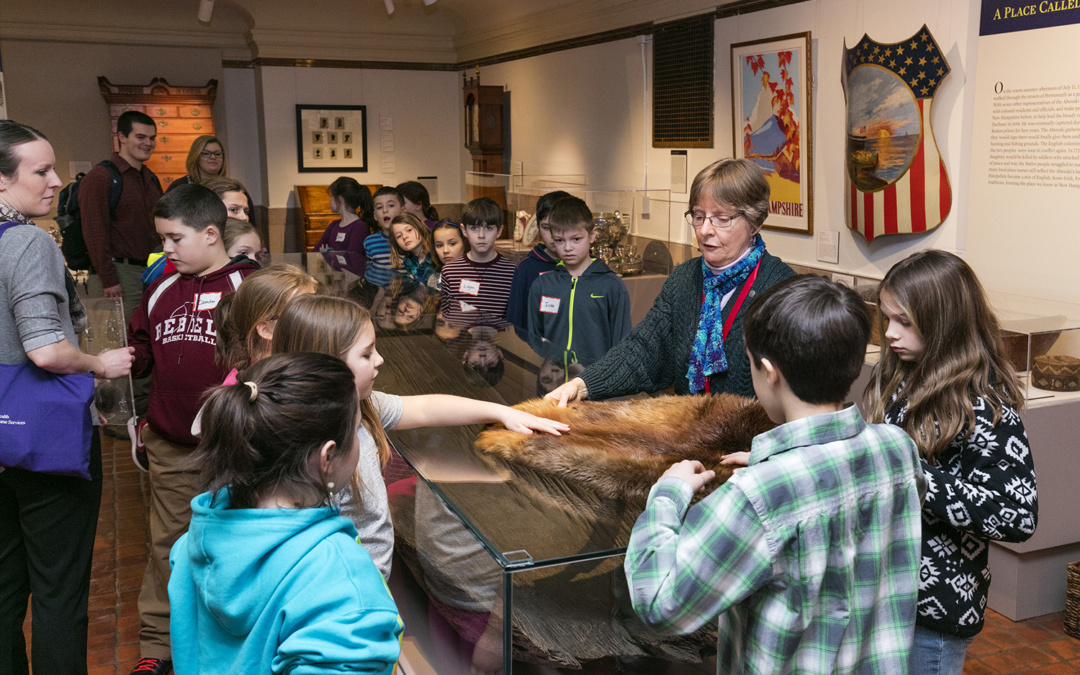With the increased importance placed on STEM education, history has in some cases been removed almost entirely from the classroom, which has provided a unique opportunity for museums on the NH Heritage Trail.
“There are 17 of us throughout New Hampshire, and it is our responsibility to educate and inspire people about American history and culture —especially the younger generations,” said Michael Culver, NH Heritage Trail President and Executive Director of the Wright Museum of WWII in Wolfeboro. “Understanding our history helps us shape our future.”

New Hampshire Historical Society museum teacher Edie Daigle exhibits a beaver pelt to fourth graders from Maple Ave. School in Goffstown, NH. The pelt is one of several “touchable” artifacts presented to students during a hands-on field trip to the Discovering New Hampshire exhibition at the Society. Courtesy of the New Hampshire Historical Society.
With many schools unable to schedule as much history in their educational programming as in the past, some museums have had to alter their own approach to accommodate such “gaps.”
“In the past four or five years, we’ve seen a precipitous decline in historical knowledge among our student visitors that has compelled us to actually modify our programs,” said Elizabeth Dubrulle of the New Hampshire Historical Society.
She said they actually removed one program— New Hampshire at War—from circulation.
“We were spending so much time explaining to kids what the American Revolution, the Civil War, and World War II were that we never had a chance to discuss the New Hampshire part,” she said.
In forming The Trail 3 years ago, Culver said they wanted to leverage the respective resources of each member museum, but he acknowledged he did not anticipate its increasingly important role.
“It’s an opportunity for all of us to work together and develop programming that addresses the educational needs that exist with our students today,” he said.
At the American Independence Museum in Exeter, Executive Director Emma Bray said they are ready to formally launch their Traveling Trunk program. Funded by the NH Charitable Foundation, the program brings the museum experience into the classroom and enables them to reach students during its closed season from December to April.
“We have developed a curriculum in partnership with teachers–and each trunk comes with over 70 items that help tell the story of New Hampshire during the Revolution,” she said. “It’s an incredible program and one we believe can enhance the educational experience for hundreds of kids annually.”
According to Dubrulle, there is current research that demonstrates a correlation between learning history and several educational outcomes that can impact a child’s long-term life outlook.
“The study of the humanities is directly tied to the development of creativity and encourages American kids—who will eventually become American workers—to innovate,” she said. “Studying history also provides essential information for sound decision-making…By looking at the challenges of the past and doing some critical thinking about what worked and what didn’t, kids hopefully apply those lessons to their own situation.”
In looking at the educational landscape across the Granite State, Culver said he believes member museums on The Trail have an opportunity to expand their respective footprints.
“We do not just preserve collections,” he said. “We are active and important members of the community and we have the capacity to educate today’s younger citizens in ways that might surprise some people…History is relevant—and the research is now bearing that out.”
The 17 museums on The Trail include the Aviation Museum, Albacore Park, American Independence Museum, Canterbury Shaker Village Castle in the Clouds, Lake Winnipesaukee Museum, Libby Museum, Millyard Museum, Museum of the White Mountains, New Hampshire Boat Museum, New Hampshire Historical Society, New Hampshire Farm Museum, Portsmouth Historical Society @ Discover Portsmouth, Remick Country Doctor Museum and Farm, The Belknap Mill, Woodman Museum, and Wright Museum of WWII.

